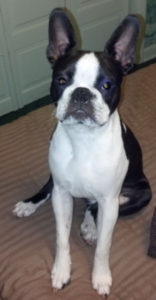We all know what our dog’s “normal” is. When it changes, notice your dog’s behavior and take action.

We keep dog odds and ends in a basket on a shelf in the kitchen. Not stuff that’s interesting to the dogs. No treats or food. Just poop bags, treat bags (empty), kongs, a long line. And our dogs know there’s “nothing to see here!” So this morning when Booker was obsessed with the basket – we knew something changed. It turned out that Simon hadn’t emptied his Kong toy the last time he got it. Treats and nut butter were wedged in there, somehow defying the dishwasher. So soggy, smelly dog treats got Booker’s attention. Thank you, Booker! Who knows if we would have seen it before it turned into an even more disgusting mess!
Change needs examination
If there’s something your dog used to do, and that changes, it’s time to dig into the mystery. If there’s something your dog never did, but now does, it needs looking at. Dogs tell us all the time about how they’re changing. It’s up to us to pay attention and find out if it’s serious, medical, silly, fun, inconsequential, or even a training break-through.
Something as simple as lighting can play a role for your dog. Tango is almost 11 now and his eyes are starting to look a little cloudy. We noticed he started to flinch in training when only hand signals were used. We changed the lighting, and our position, so that it’s brighter and shadows don’t cross his face when we gesture. A simple thing like a change of position can make a difference to your dog.
Personal preference matters
You’ll also be a better partner and friend to your dog if you notice the things your dog likes and doesn’t. We recently responded to an interview request about “things dogs hate.” There aren’t a lot of universal “hates” in the dog world (head pats, teasing), but every dog has his own list of “hates” – just like we do. Some dogs love getting their tummies rubbed. Torque thinks he’s being tortured. Simon loves getting rubbed behind his ears. Booker runs away.
People who’ve never had dogs may not think much about dog personalities, but all dog people know that each dog is an individual – just as people are. We love most all of our dogs’ quirks. And the ones we don’t, we can teach them to change. The 2-Minute-Training method is built on creating better ways to communicate with our dogs and teaching them to make good decisions.
Something’s different
When you notice your dog’s behavior change, examine the cause. Is it a change for the better? Hopefully it is and your training games are paying off. If not, think about the circumstance, retrace your steps, and play detective. If could make all the difference.
